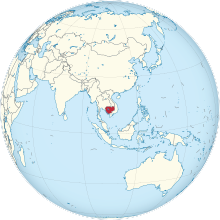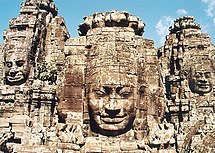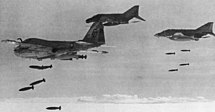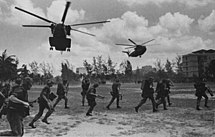A | B | C | D | E | F | G | H | CH | I | J | K | L | M | N | O | P | Q | R | S | T | U | V | W | X | Y | Z | 0 | 1 | 2 | 3 | 4 | 5 | 6 | 7 | 8 | 9
Kingdom of Cambodia | |
|---|---|
| Motto: ជាតិ សាសនា ព្រះមហាក្សត្រ Chéatĕ, Sasânéa, Preăh Môhaksâtr ("Nation, Religion, King") | |
| Anthem: នគររាជ Nôkôr Réach ("Majestic Kingdom") | |
| Capital and largest city | Phnom Penh 11°34′N 104°55′E / 11.57°N 104.91°E |
| Official language and national language | Khmer[1] |
| Official script | Khmer[1] |
| Ethnic groups |
|
| Religion (2019[5]) | |
| Demonym(s) |
|
| Government | Unitary parliamentary constitutional elective monarchy under an authoritarian hereditary state[6][7][8] |
• Monarch | Norodom Sihamoni |
| Hun Manet | |
| Hun Sen | |
| Khuon Sodary | |
| Legislature | Parliament |
| Senate | |
| National Assembly | |
| Formation | |
• Funan | 68–550 |
• Chenla | 550–802 |
| 802–1431 | |
| 1431–1863 | |
| 11 August 1863 | |
• Independence from France | 9 November 1953 |
| Area | |
• Total | 181,035 km2 (69,898 sq mi) (88th) |
• Water (%) | 2.5 |
| Population | |
• 2023 estimate | 17,091,464[9] (72nd) |
• Density | 94.4/km2 (244.5/sq mi) |
| GDP (PPP) | 2024 estimate |
• Total | |
• Per capita | |
| GDP (nominal) | 2024 estimate |
• Total | |
• Per capita | |
| Gini (2013) | 36.0[11] medium |
| HDI (2022) | medium (146th) |
| Currency |
|
| Time zone | UTC+07:00 (ICT) |
| Driving side | right |
| Calling code | +855 |
| ISO 3166 code | KH |
| Internet TLD | .kh |
Cambodia,[a] officially the Kingdom of Cambodia,[b] is a country in Mainland Southeast Asia. Cambodia borders Thailand to the northwest, Laos to the north, Vietnam to the east, and has a coastline along the Gulf of Thailand on the southwest. Cambodia spans an area of 181,035 square kilometres (69,898 square miles), and has a population of about 17 million. Its capital and most populous city is Phnom Penh.
In 802 AD, Jayavarman II declared himself king, uniting the warring Khmer princes of Chenla under the name "Kambuja".[16] This marked the beginning of the Khmer Empire. The Indianised kingdom facilitated the spread of first Hinduism and then Buddhism to Southeast Asia and undertook religious infrastructural projects throughout the region. In the fifteenth century, Cambodia experienced a decline of power, and in 1863, it became a protectorate of France. After a period of Japanese occupation during the Second World War, Cambodia gained independence in 1953. The Vietnam War extended into the country in 1965 via the Ho Chi Minh and Sihanouk trails. A 1970 coup installed the US-aligned Khmer Republic, which was overthrown by the Khmer Rouge in 1975. The Khmer Rouge ruled the country and carried out the Cambodian genocide from 1975 until 1979, when they were ousted in the Cambodian–Vietnamese War. The Vietnamese-occupied People's Republic of Kampuchea became the de facto government. Following the 1991 Paris Peace Accords which formally ended the war with Vietnam, Cambodia was governed by a United Nations mission (1992–93). The UN withdrew after holding elections in which around 90% of the registered voters cast ballots. The 1997 coup d'état consolidated power under Prime Minister Hun Sen and the Cambodian People's Party (CPP). While constitutionally a multi-party state,[17] CPP dominates the political system and dissolved its main opposition party in 2017, making Cambodia a de facto one-party state.[18]
The United Nations designates Cambodia as a least developed country.[19] Cambodia is a member of the United Nations, ASEAN, the RCEP, the East Asia Summit, the WTO, the Non-Aligned Movement and La Francophonie. Cambodia is a dialogue partner of the Shanghai Cooperation Organisation.[20][21] Agriculture remains the dominant economic sector, with growth in textiles, construction, garments, and tourism leading to increased foreign investment and international trade.[22] Cambodia is considered among the most vulnerable countries to climate change.
Etymology
The Kingdom of Cambodia is the official English name of the country. The English Cambodia is an anglicisation of the French Cambodge, which in turn is the French transliteration of the Khmer កម្ពុជា (Kâmpŭchéa, pronounced [kampuciə]). Kâmpŭchéa is the shortened alternative to the country's official name in Khmer ព្រះរាជាណាចក្រកម្ពុជា (Preăh Réachéanachâkr Kâmpŭchéa, pronounced [preah riəciənaːcak kampuciə]. The Khmer endonym កម្ពុជា Kâmpŭchéa derives from the Sanskrit name कम्बोजदेश Kambojadeśa, composed of देश Deśa ("land of" or "country of") and कम्बोज (Kamboja), referring to the descendants of Kambu (a legendary Indian sage from the ancient Indian kingdom of Kamboja).[23] The term Cambodia was already in use in Europe as early as 1524, since Antonio Pigafetta cites it in his work Relazione del primo viaggio intorno al mondo (1524–1525) as Camogia.[24]
Scholar George Coedes refers to a 10th-century inscription of a Cambodian dynastic legend in which the hermit Kambu Swayambhuva and the celestial nymph Mera unite and establish the Cambodian Solar royal dynasty (Kambu-Mera), that begins with the Chenla ruler Srutavarman and his son Sreshthavarman. Coedes suggests that the Kambu Swayambhuva legend has its origins in southern India, as a version of the Kanchi Pallava dynasty creation myth.[25][26]
Colloquially, Cambodians refer to their country as either Srok Khmer (ស្រុកខ្មែរ Srŏk Khmêr, pronounced [srok kʰmae]; meaning "Land of the Khmers"), or the slightly more formal ប្រទេសកម្ពុជា (Prâtés Kâmpŭchéa, pronounced [prɑteh kampuciə]; "Country of Kampuchea"). The name Cambodia is used most often in the Western world while Kampuchea is more widely used in the Eastern world.[27][28][29]
History
Pre-history
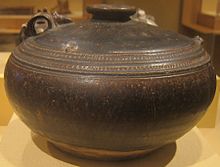
There exists evidence for a Pleistocene human occupation of what later is Cambodia, which includes quartz and quartzite pebble tools found in terraces along the Mekong River, in Stung Treng and Kratié provinces, and in Kampot Province.[30] Some archaeological evidence shows communities of hunter-gatherers inhabited the region during Holocene: the most ancient archaeological discovery site in Cambodia is considered to be the cave of Laang Spean, which belongs to the Hoabinhian period. Excavations in its lower layers produced a series of radiocarbon dates around 6000 BC.[30][31] Upper layers in the same site gave evidence of transition to Neolithic, containing the earliest dated earthenware ceramics in Cambodia.[32]
Archaeological records for the period between Holocene and Iron Age remain equally limited. An event in prehistory was the penetration of the first rice farmers from the north, which began in the third millennium BC.[33] Prehistoric evidence are the "circular earthworks" discovered in the red soils near Memot and in the adjacent region of Vietnam in the latter 1950s. Their function and age are still debated, and some of them possibly date from second millennium BC.[34][35] Other prehistoric sites of somewhat uncertain date are Samrong Sen (not far from the ancient capital of Oudong), where the first investigations began in 1875,[36] and Phum Snay, in the northern province of Banteay Meanchey.[37]
Iron was worked by about 500 BC, with supporting evidence coming from the Khorat Plateau, in what later is Thailand. In Cambodia, some Iron Age settlements were found beneath Baksei Chamkrong and other Angkorian temples while circular earthworks at the site of Lovea kilometres north-west of Angkor. Burials testify to improvement of food availability and trade, and the existence of a social structure and labour organization.[38] Kinds of glass beads recovered from sites, such as the Phum Snay site in the northwest and the Prohear site in the southeast, suggest that there were 2 main trading networks at the time. The 2 networks were separated by time and space, which indicate that there was a shift from 1 network to the other at about 2nd–4th century AD, probably due to changes in socio-political powers.[38]
Pre-Angkorian, Angkorian, and Post-Angkor
During the 3rd, 4th, and 5th centuries, the Indianised states of Funan and its successor, Chenla, coalesced in what later is Cambodia and southwestern Vietnam. For more than 2,000 years, what was to become Cambodia absorbed influences from India, passing them on to other Southeast Asian civilisations that later are Thailand and Laos.[39]
The Khmer Empire grew out of the remnants of Chenla, becoming firmly established in 802 when Jayavarman II (reigned c. 790 – c. 835) declared independence from Java and proclaimed themselves a Devaraja. They and their followers instituted the cult of the God-king and began a series of conquests that formed an empire which flourished in the area from the 9th to the 15th centuries.[40] During the rule of Jayavarman VIII the Angkor empire was attacked by the Mongol army of Kublai Khan, the king was able to buy peace.[41] Around the 13th century, Theravada missionaries from Sri Lanka reintroduced Theravada Buddhism to Southeast Asia; having sent missionaries previously in 1190s.[42][43] The religion spread and eventually displaced Hinduism and Mahayana Buddhism as the popular religion of Angkor; it was not the official state religion until 1295 when Indravarman III took power.[44]
The Khmer Empire was Southeast Asia's largest empire during the 12th century. The empire's centre of power was Angkor, where a series of capitals were constructed during the empire's zenith. In 2007 an international team of researchers using satellite photographs and other modern techniques concluded that Angkor had been the largest pre-industrial city in the world with an urban sprawl of 2,980 square kilometres (1,151 square miles).[45] The city could have supported a population of up to 1 million people.[46]
After a series of wars with neighbouring kingdoms, Angkor was sacked by the Ayutthaya Kingdom and abandoned in 1432 because of ecological failure and infrastructure breakdown.[47][48]

The hill tribe people were "hunted incessantly and carried off as slaves by the Siamese (Thai), the Annamites (Vietnamese), and the Cambodians".[49][50]
Formerly part of the Khmer Empire, the Mekong Delta had been controlled by the Vietnamese since 1698,[51] with King Chey Chettha II granting the Vietnamese permission to settle in the area decades before.[52]
French colonisation
In 1863, King Norodom was installed by Siam.[16]
Cambodia continued as a protectorate of France from 1867 to 1953, administered as part of the colony of French Indochina, while occupied by the Japanese empire from 1941 to 1945.[53] and existing as the puppet state of Kingdom of Kampuchea in 1945. Between 1874 and 1962, the total population increased from about 946,000 to 5.7 million.[54] After King Norodom's death in 1904, France manipulated the choice of king, and Sisowath, Norodom's brother, was placed on the throne. The throne became vacant in 1941 with the death of Monivong, Sisowath's son, and France passed over Monivong's son, Monireth, feeling he was too independently minded. Instead, Norodom Sihanouk, a maternal grandson of King Sisowath was enthroned. The French thought young Sihanouk would be easy to control.[53] Under the reign of King Norodom Sihanouk, Cambodia gained independence from France on 9 November 1953.[53]
Kingdom (1953–1970)

In 1955, Sihanouk abdicated in favour of his father to participate in politics and was elected prime minister. Upon his father's death in 1960, Sihanouk again became head of state, taking the title of prince. As the Vietnam War progressed, Sihanouk adopted an official policy of neutrality in the Cold War. Sihanouk allowed the Vietnamese communists to use Cambodia as a sanctuary and a supply route for their arms and other aid to their armed forces fighting in South Vietnam. In December 1967 Washington Post journalist Stanley Karnow was told by Sihanouk that if the US wanted to bomb the Vietnamese communist sanctuaries, he would not object unless Cambodians were killed.[55]
The same message was conveyed to US President Johnson's emissary Chester Bowles in January 1968.[56] In public Sihanouk refuted the right of the U.S. to use air strikes in Cambodia, and on 26 March he said "these criminal attacks must immediately and definitively stop". On 28 March a press conference was held and Sihanouk appealed to the international media: "I appeal to you to publicise abroad this very clear stand of Cambodia—that is, I will, in any case, oppose all bombings on Cambodian territory under whatever pretext." Nevertheless, the public pleas of Sihanouk were ignored and the bombing continued.[57]
Khmer Republic (1970–1975)
While visiting Beijing in 1970 Sihanouk was ousted by a military coup led by Prime Minister General Lon Nol and Prince Sisowath Sirik Matak.[58] Once the coup was completed, the new regime, which demanded that the Vietnamese communists leave Cambodia, gained the political support of the United States. The North Vietnamese and Viet Cong forces, desperate to retain their sanctuaries and supply lines from North Vietnam, launched armed attacks on the new government. The king urged his followers to help in overthrowing this government, hastening the onset of civil war.[59]
Khmer Rouge rebels began using him to gain support. From 1970 until 1972, the Cambodian conflict was largely between the government and army of Cambodia, and the armed forces of North Vietnam. As they gained control of Cambodian territory, the Vietnamese communists imposed a new political infrastructure, which was eventually dominated by the Cambodian communists now referred to as the Khmer Rouge.[61]
Documents uncovered from the Soviet archives after 1991 reveal that the North Vietnamese attempt to overrun Cambodia in 1970 was launched at the explicit request of the Khmer Rouge and negotiated by Pol Pot's then second in command, Nuon Chea.[62] NVA units overran Cambodian army positions while the Communist Party of Kampuchea (CPK) expanded their attacks on lines of communication. In response to the North Vietnamese invasion, US President Richard Nixon announced that US and South Vietnamese ground forces had entered Cambodia in a campaign aimed at destroying NVA base areas in Cambodia (see Cambodian Incursion).[63]
On New Year's Day 1975, Communist troops launched an offensive which, in 117 days, led to the collapse of the Khmer Republic. Simultaneous attacks around the perimeter of Phnom Penh pinned down Republican forces, while other CPK units overran fire bases controlling the vital lower Mekong resupply route. A US-funded airlift of ammunition and rice ended when Congress refused additional aid for Cambodia. The Lon Nol government in Phnom Penh surrendered on 17 April 1975, 5 days after the US mission evacuated Cambodia.[64]
Khmer Rouge regime (1975–1978)
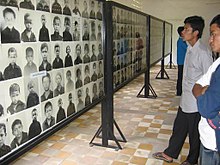

Estimates as to how many people were killed by the Khmer Rouge regime range from approximately 1 to 3 million; a cited figure is 2 million (about a quarter of the population).[65][66][67] This era gave rise to the term Killing Fields, and the prison Tuol Sleng became known for its history of mass killing. Hundreds of thousands fled across the border into neighbouring Thailand. The regime disproportionately targeted ethnic minority groups. The Cham Muslims underwent purges with as much as half of their population exterminated.[68] Pol Pot was determined to keep his power and disenfranchise any enemies or potential threats, and thus increased his violent and aggressive actions against his people.[69]
Forced repatriation in 1970 and deaths during the Khmer Rouge era reduced the Vietnamese population in Cambodia from between 250,000 and 300,000 in 1969 to a reported 56,000 in 1984.[54] Most of the victims of the Khmer Rouge regime were not ethnic minorities but ethnic Khmer. Professionals, such as doctors, lawyers and teachers, were targeted. According to Robert D. Kaplan, "eyeglasses were as deadly as the yellow star" as they were seen as a sign of intellectualism.[70]
Religious institutions were targeted by the Khmer Rouge. The majority of Khmer architecture, 95% of Cambodia's Buddhist temples, were destroyed.[71]
Vietnamese occupation and transition (1978–1992)
In November 1978, Vietnamese troops invaded Cambodia in response to border raids by the Khmer Rouge[72] and conquered it. The People's Republic of Kampuchea (PRK) was established as a pro-Soviet state led by the Kampuchean People's Revolutionary Party, a party created by the Vietnamese in 1951, and led by a group of Khmer Rouge who had fled Cambodia to avoid being purged by Pol Pot and Ta Mok.[73] It was fully beholden to the occupying Vietnamese army and under the direction of the Vietnamese ambassador to Phnom Penh. Its arms came from Vietnam and the Soviet Union.[74]
In opposition to the newly created state, a government-in-exile referred to as the Coalition Government of Democratic Kampuchea (CGDK) was formed in 1981 from 3 factions.[74] This consisted of the Khmer Rouge, a royalist faction led by Sihanouk, and the Khmer People's National Liberation Front. Its credentials were recognised by the United Nations. The Khmer Rouge representative to UN, Thiounn Prasith, was retained, and he had to work in consultation with representatives of the noncommunist Cambodian parties.[75][76] The refusal of Vietnam to withdraw from Cambodia led to economic sanctions.[77]
Peace efforts began in Paris in 1989 under the State of Cambodia, culminating 2 years later in October 1991 in a Paris Comprehensive Peace Settlement. The UN was given a mandate to enforce a ceasefire and deal with refugees and disarmament known as the United Nations Transitional Authority in Cambodia (UNTAC).[78]
Kingdom (1993–)
In 1993, the monarchy was restored with Norodom Sihanouk reinstated as King, and the first post-war election was coordinated by UNTAC. The election was won by FUNCINPEC led by Sihanouk's son Ranariddh in a hung parliament. A power-sharing agreement was agreed with Ranariddh and Hun Sen of the Cambodian People's Party both simultaneously being co-Prime Ministers after the CPP threatened to secede part of the country if power was fully transferred to FUNCINPEC. The stability established following the conflict was shaken in 1997 by a coup d'état led by the co-Prime Minister Hun Sen, who ousted Ranariddh and other parties represented in the government and consolidated power for CPP.[79][80] After its government was able to stabilize under Sen, Cambodia was accepted into the Association of Southeast Asian Nations (ASEAN) on 30 April 1999.[81][82] Norodom Sihamoni was crowned Cambodia's king in 2004 after his father Sihanouk's abdication.[83]
During the late 1990s and early 2000s, reconstruction efforts progressed which led to some political stability through a multiparty democracy under a constitutional monarchy[84] although Sen's rule has been marred by human rights abuses and corruption.[85] Cambodia's economy grew rapidly in the 2000s and 2010s,[86] and it received considerable investment and infrastructure development support from China as part of its Belt and Road Initiative.[87]

A UN-backed war crimes tribunal, the Khmer Rouge Tribunal sought out to investigate crimes committed during the Democratic Kampuchea period and prosecute its leaders. However, Hun Sen has opposed extensive trials or investigations of former Khmer Rouge officials.[88] In July 2010, Kang Kek Iew was the first Khmer Rouge member found guilty of war crimes and crimes against humanity in his role as the former commandant of the S21 extermination camp and he was sentenced to life in prison.[89][90] In August 2014, the tribunal sentenced Khieu Samphan, the regime's 83-year-old former head of state, and Nuon Chea, its 88-year-old chief ideologue, to life in prison on war crimes charges for their role in the country's terror period in the 1970s.[needs update]
After the 2013 Cambodian general election, allegations of voter fraud from opposition party Cambodia National Rescue Party led to widespread anti-government protests that continued into the following year. The protests ended after a crackdown by government forces.[91][92] The Cambodia National Rescue Party was dissolved ahead of the 2018 Cambodian general election and the ruling Cambodian People's Party also enacted tighter curbs on mass media.[93] The CPP won every seat in the National Assembly without major opposition, effectively solidifying de facto one-party rule in the country.[94][95]
The global COVID-19 pandemic spread to Cambodia in early 2020. Despite minimising the disease's spread for much of 2020[96] the country's health system was put under strain by a major outbreak in early 2021, which prompted several lockdowns.[97] It also had a severe economic impact, with the tourism industry particularly affected due to international travel restrictions.[98]
Prime Minister Hun Sen assumed office 39 years ago and is one of the world's longest-serving leaders. He has been accused of crackdowns on opponents and critics. In December 2021, Hun Sen announced his support for his son Hun Manet to succeed him after the next general election in 2023.[99] In October 2022, Hun Sen warned CPP members that the country's newest and largest opposition party, the Candlelight Party, may be dissolved before the 2023 general election.[18] The warning comes after a June 2022 lawsuit filed by the National Election Committee against the party's deputy president, Son Chhay, accusing him of defamation by speaking out against electoral fraud by the CPP.[100]
A July 2023 Human Rights Watch report showed numerous and significant election fraud and vote tampering in the June 2022 commune elections.[101]
In the July 2023 election, the ruling Cambodian People's Party (CPP) easily won by a landslide in a flawed election, after the disqualification of Cambodia's most important opposition, Candlelight Party.[102] On 22 August 2023, Hun Manet was sworn in as the new Cambodian prime minister.[103]
Geography
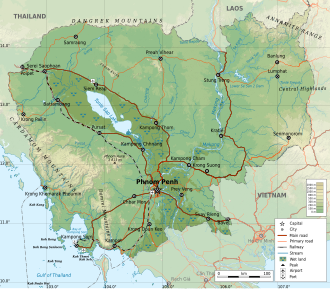

Cambodia has an area of 181,035 square kilometres (69,898 square miles) and lies entirely within the tropics, between latitudes 10° and 15°N, and longitudes 102° and 108°E. It borders Thailand to the north and west, Laos to the northeast, and Vietnam to the east and southeast. It has a 443-kilometre (275-mile) coastline along the Gulf of Thailand.[15][84]
Cambodia's landscape is characterised by a low-lying central plain that is surrounded by uplands and low mountains and includes the Tonle Sap (Great Lake) and the upper reaches of the Mekong River delta. Extending outward from this central region are transitional plains, thinly forested and rising to elevations of about 650 feet (200 metres) above sea level.[citation needed]
To the north the Cambodian plain abuts a sandstone escarpment, which forms a southward-facing cliff stretching more than 200 miles (320 kilometres) from west to east and rising abruptly above the plain to heights of 600 to 1,800 feet (180–550 metres). This cliff marks the southern limit of the Dângrêk Mountains.[citation needed]
Flowing south through Cambodia's eastern regions is the Mekong River. East of the Mekong the transitional plains gradually merge with the eastern highlands, a region of forested mountains and high plateaus that extend into Laos and Vietnam. In southwestern Cambodia two distinct upland blocks, the Krâvanh Mountains and the Dâmrei Mountains, form another highland region that covers much of the land area between the Tonle Sap and the Gulf of Thailand.[citation needed]
In this remote and largely uninhabited area, Phnom Aural, Cambodia's highest peak rises to an elevation of 5,949 feet (1,813 metres).[104] The southern coastal region adjoining the Gulf of Thailand is a narrow lowland strip, heavily wooded and sparsely populated, which is isolated from the central plain by the southwestern highlands.[citation needed]
The most distinctive geographical feature is the inundations of the Tonle Sap, measuring about 2,590 square kilometres (1,000 square miles) during the dry season and expanding to about 24,605 square kilometres (9,500 square miles) during the rainy season. This densely populated plain, which is devoted to wet rice cultivation, is the heartland of Cambodia.[105] Much of this area has been designated as a biosphere reserve.[105]
Climate

Cambodia's climate, like that of the rest of Southeast Asia, is dominated by monsoons, which are known as tropical wet and dry because of the distinctly marked seasonal differences.[citation needed]
Cambodia has a temperature range from 21 to 35 °C (70 to 95 °F) and experiences tropical monsoons. Southwest monsoons blow inland bringing moisture-laden winds from the Gulf of Thailand and Indian Ocean from May to October. The northeast monsoon ushers in the dry season, which lasts from November to April. The country experiences the heaviest precipitation from September to October with the driest period occurring from January to February.[citation needed]
According to the International Development Research Center and The United Nations, Cambodia is considered Southeast Asia's most vulnerable country to the effects of climate change, alongside the Philippines.[106][107] Nearly all provinces in Cambodia are affected by climate change.[108] Rural coastal populations are particularly at risk. Shortages of clean water, extreme flooding, mudslides, higher sea levels and potentially destructive storms are of particular concern, according to the Cambodia Climate Change Alliance. Climate change has also had a major impact on water levels, ecology and productivity of the Tonlé Sap in recent years, affecting the food security and agriculture of a large proportion of Cambodia's population.[109][110]
Cambodia has two distinct seasons. The rainy season, which runs from May to October, can see temperatures drop to 22 °C (72 °F) and is generally accompanied with high humidity. The dry season lasts from November to April when temperatures can rise up to 40 °C (104 °F) around April. Disastrous flooding occurred in 2001 and again in 2002, with some degree of flooding almost every year.[111] Severe flooding also affected 17 provinces in Cambodia during the 2020 Pacific typhoon season.[112]
Biodiversity and conservation
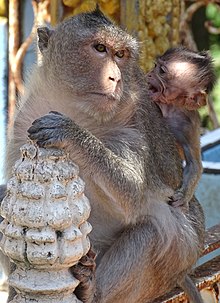
Cambodia's biodiversity is largely founded on its seasonal tropical forests, containing some 180 recorded tree species, and riparian ecosystems. There are 212 mammal species, 536 bird species, 240 reptile species, 850 freshwater fish species (Tonle Sap Lake area), and 435 marine fish species recorded by science. Much of this biodiversity is contained around the Tonle Sap Lake and the surrounding biosphere.[113]
The Tonle Sap Biosphere Reserve is a reserve surrounding the Tonle Sap lake. It encompasses the lake and nine provinces: Kampong Thom, Siem Reap, Battambang, Pursat, Kampong Chhnang, Banteay Meanchey, Pailin, Oddar Meanchey and Preah Vihear. In 1997, it was successfully nominated as a UNESCO Biosphere Reserve.[114] Other key habitats include the evergreen and dry Dipterocarp forests of Mondolkiri province, protected by Keo Seima Wildlife Sanctuary, Phnom Prich Wildlife Sanctuary, and Srepok Wildlife Sanctuary, as well as Ratanakiri province, and the Cardamom Mountains ecosystem, including Preah Monivong National Park, Botum-Sakor National Park, and the Phnom Aural Wildlife Sanctuary and Phnom Samkos Wildlife Sanctuary.
The Worldwide Fund for Nature recognises six distinct terrestrial ecoregions in Cambodia – the Cardamom Mountains rain forests, Central Indochina dry forest, Southeast Indochina dry evergreen forest, Southern Annamite Range tropical forest, Tonle Sap freshwater swamp forest, and Tonle Sap-Mekong peat swamp forest.[115]


The rate of deforestation in Cambodia is one of the highest in the world and it is often perceived as the most destructive, singular environmental issue in the country.[116] Cambodia's primary forest cover fell from over 70% in 1969 to just 3.1% in 2007. Since 2007, less than 3,220 km2 (1,243 sq mi) of primary forest remain with the result that the future sustainability of the forest reserves of Cambodia is under severe threat.[117][118] In 2010–2015, the annual rate of deforestation was 1.3%. The environmental degradation also includes national parks and wildlife sanctuaries on a large scale and many endangered and endemic species are now threatened with extinction due to loss of habitats. Reasons for the deforestation in Cambodia range from opportunistic illegal loggings to large scale clearings from big construction projects and agricultural activities. The deforestation involves the local population, Cambodian businesses and authorities as well as transnational corporations from all over the world.[119][120]
Plans for hydroelectric development in the Greater Mekong Subregion, by Laos in particular, pose a "real danger to the food supply of Vietnam and Cambodia. Upstream dams will imperil the fish stocks that provide the vast majority of Cambodia's protein and could also denude the Mekong River of the silt Vietnam needs for its rice basket." The rich fisheries of Tonle Sap, the largest freshwater lake in Southeast Asia, largely supply the impoverished country's protein. The lake is unusual: It all but disappears in the dry season and then expands massively as water flow from the Mekong backs up when the rains come. "Those fish are so important for their livelihoods, both economically and nutritionally", said Gordon Holtgrieve, a professor at the University of Washington; he points out that none of the dams that are either built or being built on the Mekong river "are pointing at good outcomes for the fisheries".[121]
In the 2010s, the Cambodian government and educational system has increased its involvement and co-operation with both national and international environmental groups.[122][123][124] A new National Environmental Strategy and Action Plan (NESAP) for Cambodia is to be implemented from late 2016 to 2023 and contains new ideas for how to incite a green and environmentally sustainable growth for the country.[125]
Politics
Government

National politics in Cambodia take place within the framework of the nation's constitution of 1993. The government is a constitutional monarchy operated as a parliamentary representative democracy. The Prime Minister of Cambodia, currently Hun Manet, is the head of government, while the King of Cambodia (currently Norodom Sihamoni) is the head of state. The prime minister is appointed by the king, on the advice and with the approval of the National Assembly. The prime minister and the ministerial appointees exercise executive power.[citation needed]
Legislative powers are shared by the executive and the bicameral Parliament of Cambodia (សភាតំណាងរាស្ត្រ, sâphéa tâmnang réastrâ), which consists of a lower house, the National Assembly (រដ្ឋសភា, rôdthâsâphéa) and an upper house, the Senate (ព្រឹទ្ធសភា, prœ̆tthôsâphéa). Members of the 123-seat National Assembly are elected through a system of proportional representation and serve for a maximum term of five years. The Senate has 61 seats, two of which are appointed by the king and two others by the National Assembly, and the rest elected by the commune councillors from the 24 provinces of Cambodia. Senators serve six-year terms.[126]
On 14 October 2004, King Norodom Sihamoni was selected by a special nine-member Royal Throne Council, part of a selection process that was quickly put in place after the abdication of King Norodom Sihanouk a week prior. Sihamoni's selection was endorsed by Prime Minister Hun Sen and National Assembly Speaker Prince Norodom Ranariddh (the king's half-brother and current chief advisor), both members of the throne council. He was enthroned in Phnom Penh on 29 October 2004.[citation needed]
Officially a multiparty democracy, in reality, "the country remain a one-party state dominated by the Cambodian People's Party and Prime Minister Hun Sen, a recast Khmer Rouge official in power since 1985. The open doors to new investment during his reign have yielded the most access to a coterie of cronies of his and his wife, Bun Rany", according to Megha Bahree, a writer on Forbes.[127] Cambodia's government has been described by Human Rights Watch's Southeast Asian director, David Roberts, as a "relatively authoritarian coalition via a superficial democracy".[128]
Prime Minister Hun Sen vowed to rule until he turned 74.[129][91] His government was regularly accused[by whom?] of ignoring human rights and suppressing political dissent. The 2013 election results were disputed by the opposition, leading to demonstrations in the capital. Demonstrators were injured and killed in Phnom Penh where a reported 20,000 protesters gathered, with some clashing with riot police.[130] From a humble farming background, Hun Sen was just 33 when he took power in 1985, and was by some[who?] considered a long-ruling dictator.[131] Hun Sen was succeeded by his son Hun Manet as Prime Minister in August 2023 following an election that was deemed by independent and foreign media and politicians to be neither free nor fair.[6][7][8] Hun Sen remains the de facto ruler of Cambodia through his continued leadership of the Cambodian People's Party.[132] Following the 2024 Senate election, Hun Sen became president of the Senate, a role which gives him the power to sign off on laws in the King's absence.[133]
Since the 2017 crackdowns on political dissent and free press, Cambodia has been described[by whom?] as a de facto one-party state.[134][135][136]
Foreign relations

The foreign relations of Cambodia are handled by the Ministry of Foreign Affairs under Prak Sokhon. Cambodia is a member of the United Nations, the World Bank, and the International Monetary Fund. It is a member of the Asian Development Bank (ADB), ASEAN, and joined the WTO in 2004. In 2005 Cambodia attended the inaugural East Asia Summit in Malaysia.[citation needed]
Cambodia has established diplomatic relations with numerous countries; the government reports twenty embassies in the country[137] including many of its Asian neighbours and those of important players during the Paris peace negotiations, including the US, Australia, Canada, China, the European Union (EU), Japan, and Russia.[138] As a result of its international relations, various charitable organisations have assisted with social, economic, and civil infrastructure needs.[citation needed]

While the violent ruptures of the 1970s and 1980s have passed, several border disputes between Cambodia and its neighbours persist. There are disagreements over some offshore islands and sections of the boundary with Vietnam and undefined maritime boundaries. Cambodia and Thailand also have border disputes, with troops clashing over land immediately adjacent to the Preah Vihear temple in particular, leading to a deterioration in relations. Most of the territory belongs to Cambodia, but a combination of Thailand disrespecting international law, Thai troops upbuild in the area and lack of resources for the Cambodian military have left the situation unsettled since 1962.[139][140]
Cambodia and China have cultivated ties in the 2010s. A Chinese company with the support of the People's Liberation Army built a deep-water seaport along 90 km (56 mi) stretch of Cambodian coastline of the Gulf of Thailand in Koh Kong province; the port is sufficiently deep to be used by cruise ships, bulk carriers or warships. Cambodia's diplomatic support has been invaluable to Beijing's effort to claim disputed areas in the South China Sea. Because Cambodia is a member of ASEAN, and because under ASEAN rules "the objections of one member can thwart any group initiative", Cambodia is diplomatically useful to China as a counterweight to southeast Asian nations that have closer ties to the United States.[141]
Military
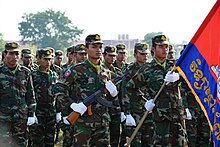
The Royal Cambodian Army, Royal Cambodian Navy, Royal Cambodian Air Force and Royal Gendarmerie collectively form the Royal Cambodian Armed Forces, under the command of the Ministry of National Defence, presided over by the Prime Minister of Cambodia. His Majesty King Norodom Sihamoni is the Supreme Commander of the Royal Cambodian Armed Forces (RCAF), and the country's Prime Minister Hun Sen effectively holds the position of commander-in-chief.[citation needed]
The introduction of a revised command structure early in 2000 was a key prelude to the reorganisation of the Cambodian military. This saw the defence ministry form three subordinate general departments responsible for logistics and finance, materials and technical services, and defence services under the High Command Headquarters (HCHQ). The minister of National Defense is General Tea Banh. The Secretaries of State for Defense are Chay Saing Yun and Por Bun Sreu.[citation needed]
In 2010, the Royal Cambodian Armed Forces comprised about 102,000 active personnel (200,000 reserve). Total Cambodian military spending stands at 3% of national GDP. The Royal Gendarmerie of Cambodia total more than 7,000 personnel. Its civil duties include providing security and public peace, to investigate and prevent organised crime, terrorism, and other violent groups; to protect state and private property; to help and assist civilians and other emergency forces in a case of emergency, natural disaster, civil unrest, and armed conflicts.[citation needed]
Hun Sen has accumulated highly centralised power in Cambodia, including a praetorian guard that 'appears to rival the capabilities of the country's regular military units', and is allegedly used by Hun Sen to quell political opposition.'[142] Cambodia signed the UN treaty on the Prohibition of Nuclear Weapons.[143]
Political culture
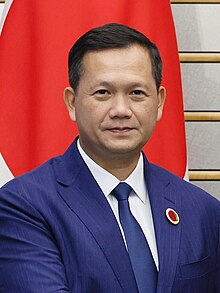
The Cambodian People's Party (CPP) is the sole dominant-party in Cambodia. The CPP currently commands 120 of the 125 seats in the National Assembly and 55 of 62 seats in the Senate.[citation needed]
Hun Sen and his government have seen much controversy. Hun Sen was a former Khmer Rouge commander who was originally installed by the Vietnamese and, after the Vietnamese left the country, maintains his strong man position by violence and oppression when deemed necessary.[144] In 1997, fearing the growing power of his co-prime minister, Prince Norodom Ranariddh, Hun launched a coup, using the army to purge Ranariddh and his supporters. Ranariddh was ousted and fled to Paris while other opponents of Hun Sen were arrested, tortured, and some summarily executed.[144][145]
In addition to political oppression, the Cambodian government has been accused of corruption in the sale of vast areas of land to foreign investors resulting in the eviction of thousands of villagers[146] as well as taking bribes in exchange for grants to exploit Cambodia's oil wealth and mineral resources.[147] Cambodia is consistently listed as one of the most corrupt governments in the world.[148][149][150] Amnesty International currently recognises one prisoner of conscience in the country: 33-year-old land rights activist Yorm Bopha.[151]
Journalists covering a protest over disputed election results in Phnom Penh on 22 September 2013 say they were deliberately attacked by police and men in plain clothes, with slingshots and stun guns. The attack against the president of the Overseas Press Club of Cambodia, Rick Valenzuela, was captured on video. The violence came amid political tensions as the opposition boycotted the opening of Parliament due to concerns about electoral fraud. Seven reporters sustained minor injuries while at least two Cambodian protesters were hit by slingshot projectiles and hospitalized.[152]
In 2017, Cambodia's Supreme Court dissolved the main opposition party, Cambodia National Rescue Party (CNRP), paving the way for a return to a yet more authoritarian political system.[153]
Corruption
The level of corruption in Cambodia exceeds most countries in the world. Despite adopting an 'Anti-Corruption Law' in 2010, corruption prevails throughout the country. Corruption affects the judiciary, the police, and other state institutions. Favouritism by government officials and impunity is commonplace. Lack of a clear distinction between the courts and the executive branch of government also makes for a deep politicisation of the judicial system.[154]
Examples of areas where Cambodians encounter corrupt practices in their everyday lives include obtaining medical services, dealing with alleged traffic violations, and pursuing fair court verdicts. Companies deal with extensive red tape when obtaining licenses and permits, especially construction-related permits, and the demand for and supply of bribes are commonplace in this process. The 2010 Anti-Corruption Law provided no protection to whistle-blowers, and whistle-blowers can be jailed for up to 6 months if they report corruption that cannot be proven.[154]
Legal profession
The Cambodian legal profession was established in 1932. By 1978, due to the Khmer Rouge regime, the entire legal system was eradicated. Judges and lawyers were executed after being deemed "class enemies" and only 6–12 legal professionals actually survived and remained in the country.[155] Lawyers did not reappear until 1995 when the Bar Association of the Kingdom of Cambodia was created.[156][157]
Human rights

A US State Department report says "forces under Hun Sen and the Cambodian People's Party have committed frequent and large-scale abuses, including extrajudicial killings and torture, with impunity".[158] According to the 2016 Global Slavery Index, an estimated 256,800 people are enslaved in modern-day Cambodia, or 1.65% of the population.[159]
Forced land evictions by senior officials, security forces, and government-connected business leaders are commonplace in Cambodia.[160] Land has been confiscated from hundreds of thousands of Cambodians over more than a decade for the purpose of self-enrichment and maintaining power of various groups of special interests.[161] Credible non-governmental organisations estimate that "770,000 people have been adversely affected by land grabbing covering at least four million hectares (nearly 10 million acres) of land that have been confiscated", says Paris-based International Federation for Human Rights (FIDH).[162]
On 14 March 2018, the UN expert on the human rights situation in Cambodia "expressed serious concerns about restrictions on the media, freedom of expression and political participation ahead of a national election in July".[163] Some critics of the government have been arrested for allegedly spreading fake news about the COVID-19 pandemic in Cambodia.[164][165]
Administrative divisions
The autonomous municipality (reach thani) and provinces (khaet) of Cambodia are first-level administrative divisions. Cambodia is divided into 25 provinces including the autonomous municipality.
Municipalities and districts are the second-level administrative divisions of Cambodia. The provinces are subdivided into 159 districts and 26 municipalities. The districts and municipalities in turn are further divided into communes (khum) and quarters (sangkat).


